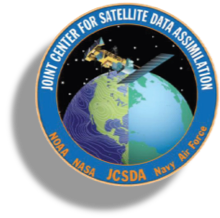In a recent collaborative effort between the Joint Center for Satellite Data Assimilation (JCSDA) and the Global Modeling and Assimilation Office (GMAO), we have successfully integrated the newly released Level 2 TEMPO NO2 products into the JEDI data assimilation system using the GEOS-CF model at C360/~25km resolution (the background and the analysis are at the same resolution). This initiative demonstrates the enhanced capability to monitor and produce analyses of atmospheric composition less than 24 hours after official product release, focusing on NO2, a significant pollutant and tracer for air quality.
Figure 1. NO2 tropospheric columns OMA vs OMB for April 6, 2024
The first visual (Figure 1) showcases the comparison between the observation minus analysis (OMA) and the observation minus forecast (OMB) for NO2. This analysis is crucial as it highlights the differences between the observed NO2 concentrations and those predicted by the model both before and after the assimilation process. The left panel depicts the OMA, indicating the performance of the analysis step, while the right panel presents the OMB, illustrating the initial discrepancies between observations and the model forecast.
Figure 2. Analysis increments of NO2 concentrations at the surface
The second visual (Figure 2) displays the analysis increments for NO2 at the surface, showing how the model's initial conditions are adjusted during the assimilation process to better match the observations. The increments are a direct measure of the impact of the assimilation on the model state, providing insights into where and how the model is corrected based on the TEMPO NO2 observations.
The analysis is at 25km horizontal resolution and employs a 6-hourly window using a very coarse temporal resolution 3DFGAT method, with the NRT GEOS-CF outputs only available every 3 hours for now. As we see in the figures, the middle of the day assimilation window (window center is 18Z) analysis works fairly well and corrects the features of differences seen in the OMB. This is not really the case for the morning and evening assimilation windows (window center at 12Z and 00Z), where the 3DVar methods are not working efficiently, resulting in somewhat degraded OMA with stronger increments not correctly spread across time (the result would be similar with an EnKF). This inefficiency arises because the temporal variations of NO2 are very large during these times, making a 3D analysis far from optimal and clearly justifying 4D analysis methodologies for geostationary instruments like TEMPO.
Thankfully, JCSDA has been developing 4DVar and 4DEnVar capabilities. These methods were demonstrated and released for atmospheric composition at low analysis resolution (C90/~100km) for the skylab-V8 release in March 2024. These 4D methodologies will be utilized for TEMPO assimilation. The JCSDA also plans to enhance the 4DEnVar methodology to not only update concentrations but also constrain emissions. This enhancement will be a major focus of the JCSDA atmospheric composition team's work over the next 12 months.
As a bonus, in figure 3 we showcase the OMB during the path of the eclipse's totality on April 8th 2024. The figure shows a massive blob of positive differences over Texas as the quality flags used for data assimilation were not discarding those observations. TEMPO is a UV and Visible instrument; therefore it is not meant to retrieve quantities in “nighttime conditions”. Work is in progress as we will need to refine our quality flags such as cloud fraction, observation error tuning and report anomalies, such as the eclipse, to the NASA TEMPO retrieval team to improve the product.
Figure 3. NO2 tropospheric columns OMB for April 8 2024 at 18Z during the total solar eclipse path.
Integrating TEMPO NO2 data into the JEDI data assimilation system with the GEOS-CF model is a significant achievement. It demonstrates the effectiveness of collaborative efforts in advancing atmospheric science and improving environmental monitoring capabilities. This is a new step towards enhancing our capability for better understanding processes that drive US air quality. This also demonstrates the JEDI system building operational capacity for data assimilation. The goal is to provide a system architecture that can deliver rapidly meaningful information for policymakers and scientists to address air quality and climate change challenges.
This effort highlights the successful collaboration between JCSDA and GMAO, showcasing the potential of integrated systems to enhance our understanding and prediction of atmospheric composition. As we continue to refine these methods and incorporate more observational data, we anticipate even greater improvements in our ability to monitor and predict air quality on regional and global scales.
Stay tuned for further JCSDA updates and detailed analysis as we continue to enhance our data assimilation techniques and incorporate additional satellite data to improve the accuracy and reliability of our atmospheric models.
Acknowledgements
This work was led by Jerome Barre, with special help from Maryam Abdi-Oskouei, Ashley Griffin (JCSDA), Emma Knowland, Viral Shah, (NASA/GMAO), Christoph Keller (formerly NASA/GMAO, now at Swiss RE) and of course, the TEMPO retrieval team that produced the observations!
Photo by Michael Michelovski on Unsplash




